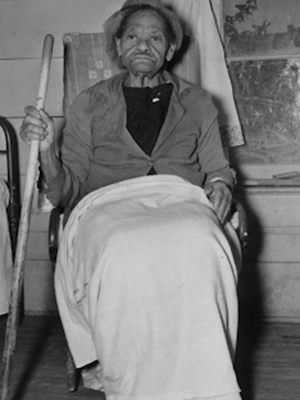Mary Reynolds
As a formerly enslaved woman, Mary Reynolds grew up humiliated and traumatized on the Kilpatrick plantation in Blackriver, Louisiana. She lived and witnessed slavery in all its cruelty. She was malnourished, overworked, and beaten to the point of infertility. In her WPA interview, she recalls “What I hated most was when they’d beat me and I didn’t know what they beat me for, and I hated them strippin’ me naked as the day I was born”. While her story is common for those enslaved, Reynolds also experienced the arbitrary nature of the system. She was sold because Kilpatrick’s daughter had become too fond of her, only to then be repurchased because his daughter worried herself sick at the loss of Reynolds. She also witnessed the privileges given to Ms. Margaret, a “yaller” (light-skinned) black woman bought specifically to sew finer clothing for the master’s family with whom Kilpatrick had a long term affair and children. Upon detailing her life-story, her final reflection was: “Slavery was the worst days was ever seed in the world. They was things past tellin’, but I got the scars on my old body to show to this day. I seed worse than what happened to me… I ’members ’out the days of slavery and I don’t believe they ever going have slaves no more on this earth. I thank God done took that burden off his black children and I’m aimin’ to praise him for it to his face in the days of Glory…”.
LaNiyah Grovell ’27
Look around at today’s celebrities, specifically, at the fabulous couture clothing that adorns their bodies. While these extravagant garments may feel like the height of fashion technology, they are simply the most recent evolution of three basic elements: fabric, thread, and the tool needed to piece it together – the sewing needle. The first sewing needle, appeared 80,000 years ago in South Africa in conjunction with Middle Paleolithic clothing fabrication, was a bone-awl. This tool, often made of bird bone with one pointed end, was used to create holes that can be laced through. Around 45,000 years ago, the next iteration of the sewing needle, one with an eye, appeared in what is now Siberia and China. Then, around the time of the Iron Age, came needles made of bronze and iron. Around 2,300 years ago, the ingenuity of Indian metalsmiths allowed needles to be made from less brittle steel material. The sewing needle has since only varied in flatness, length, and content depending on the intended use and the materials available to regions of the world. Today, the most common needle is one made of high carbon steel wire and mainly exported from Vietnam. From the gorgeous gowns on the runway to the ripped jeans you may be wearing today, each and every garment has been hand finished with this simple, ancient tool. – LaNiyah Grovell
Sources
- Narrative of Mary Reynolds, Enslaved in Louisiana, ca. 1832-1865
-
Sewing Needles Reveal the Roots of Fashion
